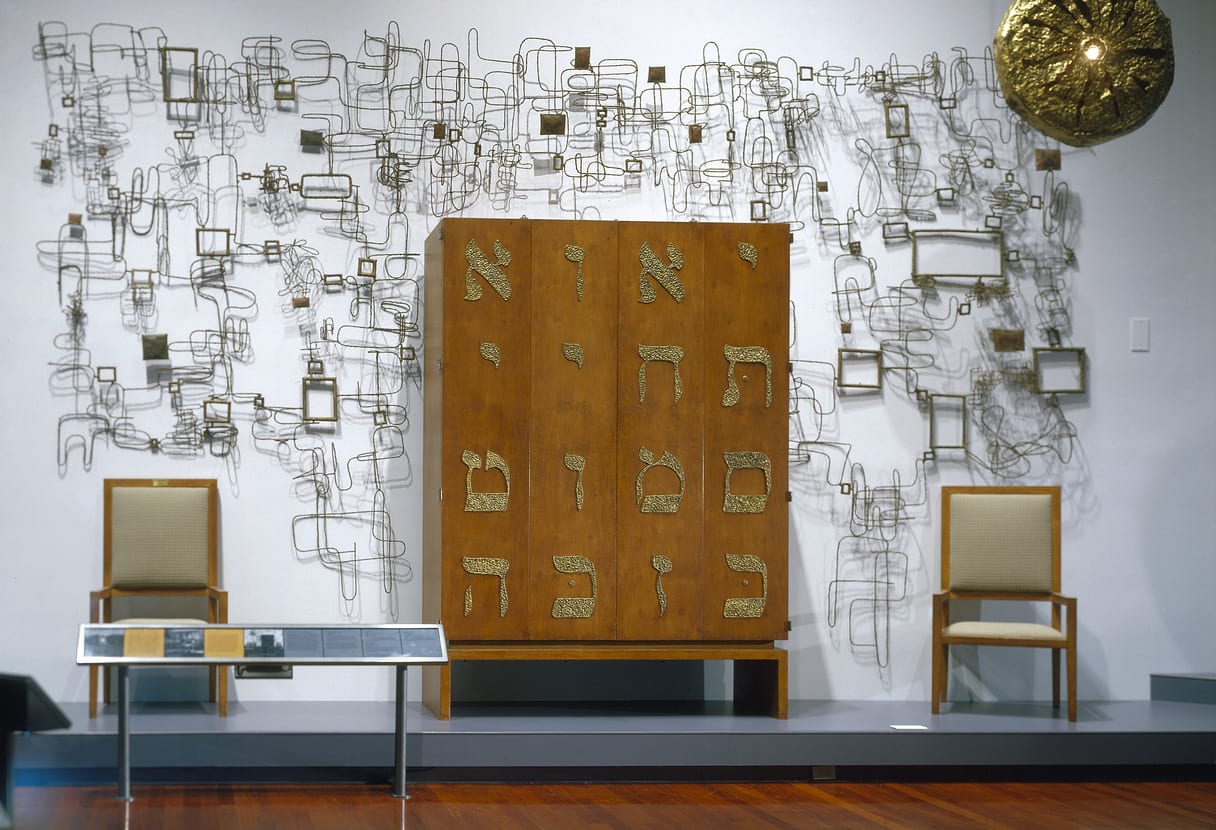
- Object Name:
- Synagogue Wall Sculpture
- Artist/Maker:
- Ibram Lassaw
- Bio:
- American, b. Egypt, 1913-2003
- Title:
- Creation
- Place Made:
- United States
- Date:
- 1956–57
- Medium:
- Wire covered with bronze rod and copper sheet
- Dimensions:
- 140 × 372 × 14 in. (355.6 × 944.9 × 35.6 cm)
- Credit Line:
- Purchase: Contemporary Judaica Acquisitions Committee Fund; Dr. Harry G. Friedman, by exchange; Mrs. Bernhard Kahn, by exchange; Judaica Acquisitions Fund; and Dorothy George Baker, by exchange
- Accession Number:
- 2006-58a-h
Not On View
Kneses Tifereth Israel is a classic example of 1950s synagogue design that reflects the growth in American Jewish life in the post-war era when more than 500 synagogues were built throughout the United States. Philip Johnson (1906-2005) was one of the leading American voices for Modernism, first as head of the Museum of Modern Art's architecture and design department in the 1930s, and subsequently as a leading architect. Kneses Tifereth Israel was his only synagogue design. He undertook the commission for no fee as a public atonement to the Jewish people for his pro-fascist activities in the 1930s. In its adoption of a Modernist style, the Port Chester congregation reflected the movement at the time to develop new themes and forms appropriate to the contemporary synagogue.
When Kneses Tifereth Israel opened in 1956, Philip Johnson turned to Ibram Lassaw to commission a suite of works for the bimah (the platform in a synagogue from which the Torah is read). These included a large bimah screen (entitled Creation and measuring approximately 31 feet x 12 feet), an eternal light, and a menorah. In addition, Johnson designed the Torah ark (of English oak decorated with bronze Hebrew letters made by Lassaw) and other furnishings including a number of bimah chairs of English oak. In 2006, when Kneses Tifereth Israel decided to renovate the sanctuary, the Lassaw and Johnson suite (with the exception of the menorah) was sold to The Jewish Museum.
Creation, Lassaw's bimah screen for Kneses Tifereth Israel, is his most monumental work. In 1986, Lassaw described Creation as "a symphony structured in space rather than sound . . . inspired by the starry fields, the galaxies and galactic clusters of which we are a part."
When Kneses Tifereth Israel opened in 1956, Philip Johnson turned to Ibram Lassaw to commission a suite of works for the bimah (the platform in a synagogue from which the Torah is read). These included a large bimah screen (entitled Creation and measuring approximately 31 feet x 12 feet), an eternal light, and a menorah. In addition, Johnson designed the Torah ark (of English oak decorated with bronze Hebrew letters made by Lassaw) and other furnishings including a number of bimah chairs of English oak. In 2006, when Kneses Tifereth Israel decided to renovate the sanctuary, the Lassaw and Johnson suite (with the exception of the menorah) was sold to The Jewish Museum.
Creation, Lassaw's bimah screen for Kneses Tifereth Israel, is his most monumental work. In 1986, Lassaw described Creation as "a symphony structured in space rather than sound . . . inspired by the starry fields, the galaxies and galactic clusters of which we are a part."
Information may change as a result of ongoing research.